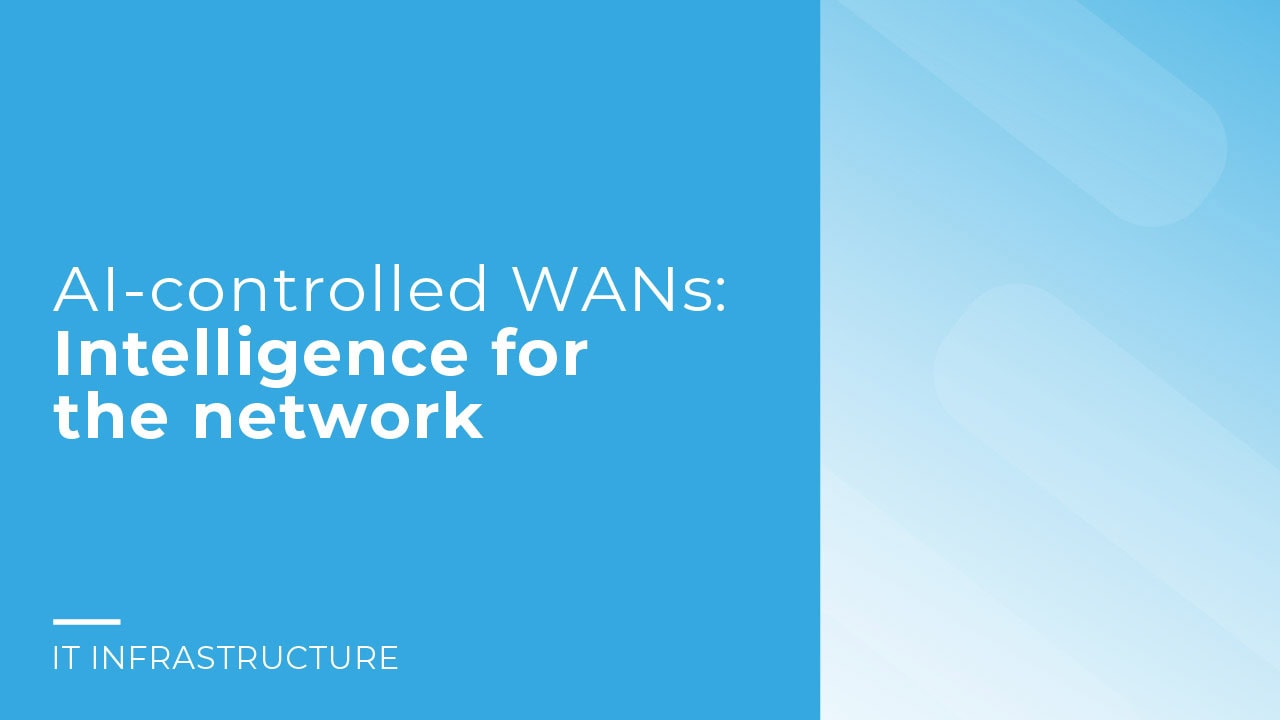
Can artificial intelligence improve and support the operation of networks?
The IT world is undergoing a major shift from traditional, outdated methods to automated solutions such as AIOps or SDN. The growing number of devices, users and applications makes manual troubleshooting increasingly impractical. Artificial intelligence and machine learning are therefore crucial tools for keeping up with the demands of digital transformation. Wide area networks (WANs) have also changed over time, particularly in terms of how users use and access data and applications. SDN has significantly improved traditional networks, but the demands on WANs have continued to change dramatically due to an increasingly mobile workplace.
The future of network technology lies in AI-driven solutions that offer more efficient troubleshooting, adaptability and security. It is important to recognize and leverage the potential of AI for network infrastructure, but also to consider the associated risks. In this blog post, we explain what wide area networks are, how AI is used in this context and what potential and risks AI-driven WANs have for the future.
WAN, or “Wide Area Network”, is a comprehensive network of computers that connects different locations over large distances. In contrast to local networks, a WAN extends over large geographical areas such as countries or even continents.
WANs play a key role in global communication by enabling companies to communicate and exchange data across locations. Various transmission protocols and technologies are used here, such as IP/MPLS or SDH. Virtual Private Networks (VPN) can also be used to ensure secure and reliable connections. Wireless variants such as the Wireless Wide Area Network (WWAN) offer additional flexibility and mobility for users.
Advantages of WANs:
Find out more in our blog post “Network types decoded: Your comprehensive guide to WAN, LAN, WLAN, VLAN, CAN, GAN, MAN, PAN and VPN”.
The ever-increasing digitization of workflows and data volumes presents a complex challenge for networks, as it is difficult to analyze, monitor and manage. Artificial intelligence offers a solution by developing algorithms to enable machine learning and automate complex tasks, which can help expand businesses.
AI is becoming increasingly important in business informatics, although its full potential has yet to be realized. Machine learning and neural networks play an important role in recognizing patterns in data and solving complex problems. AI is used in areas such as speech recognition, autonomous driving and medical diagnoses. The rapid development of AI offers both opportunities and challenges for science, business and society.
Advantages of AI:
In our blog post “AI in the IT world: the growth revolution of the future”, you can find out more about artificial intelligence.
The future development of the AI-based network promises innovative solutions that offer significant advances over current systems. AI and machine learning will soon play a key role in traffic engineering of ISP networks and in software-defined WANs. They will also become increasingly important in security management within SASE networks. In these areas, they analyze data that conventional network management systems cannot process.
A software-based solution helps to increase the flexibility of companies by speeding up the provision of services and simplifying the adjustment of bandwidth. In contrast, traditional hardware-based networks often reach their limits when it comes to meeting the dynamic requirements of modern businesses. This is where the concept of the software-defined wide area network (SD-WAN) comes in and solves these bottlenecks through three core functions of AI-WAN:
One example of this is Juniper's AI-driven SD-WAN, which aims to simplify network operations in companies. To this end, the manufacturer provides Session Smart Router (SSR) technologies that can be operated entirely via the Juniper Mist Cloud and the company's AI engine. These technologies are designed to improve wired and wireless access operations. Juniper has also enhanced the security capabilities of its SSR portfolio to enable easy deployment, secure operation and troubleshooting in WAN edge environments. We carry a wide range of Juniper-branded IT equipment, including switches, transceivers and routers. These products are designed to support your business. On our website you will not only find the manufacturer Juniper, but also well-known manufacturers such as APC, HPE Aruba and Cisco.
Companies can quickly deploy their IT networks and adjust bandwidth without having to make complex configuration changes. A software solution accelerates business growth without the need for major network redesigns and extensive capacity planning. It is expected that AI and machine learning will be extended to other areas of the network in the future.
AI-driven WANs offer numerous application possibilities in various areas. That helps to improve the user experience, optimize operational processes and enable efficient network management. This results in many benefits:
Network visibility and control
Improved efficiency through AI automation
Optimization of operating processes with AI
Improved management of the IT budget
Therefore, AI-driven WANs play an important role by helping with everything from securing your network to automating processes and handling a variety of tasks more efficiently.
Data security and data protection
Dependence on AI algorithms and complexity of troubleshooting
Continuous maintenance and updating
Technically sophisticated integration
In the future, companies could increasingly rely on AI-driven WANs as part of their network infrastructure to achieve more efficient troubleshooting, adaptability and security. Our blog post “Build IT infrastructure and benefit from improved processes” explains how you can further develop your IT infrastructure.
To meet the demands of the future, AI WANs must therefore undergo further development, as a focus on security is essential. However, the implementation of AI-driven WANs also poses challenges for your company. These include technically demanding integrations, ensuring data security and dependency on AI algorithms. To fully realize the benefits of AI-driven WANs and overcome the challenges, it is important that you invest in training your staff and ensure that your employees have the necessary qualifications and skills.
Overall, the future of network technology is heavily dependent on the integration of AI-driven WANs. By taking the right steps, you can harness the power of AI to future-proof your network infrastructure.